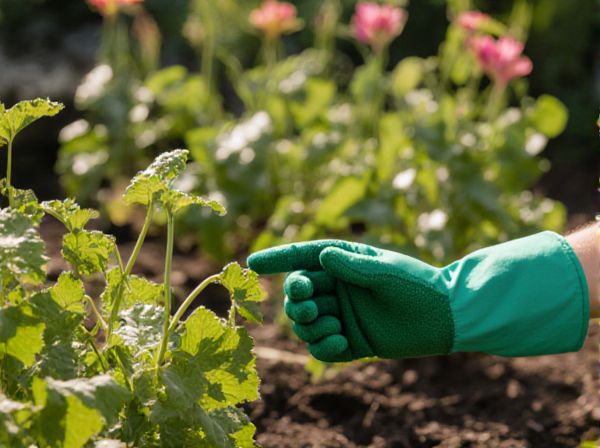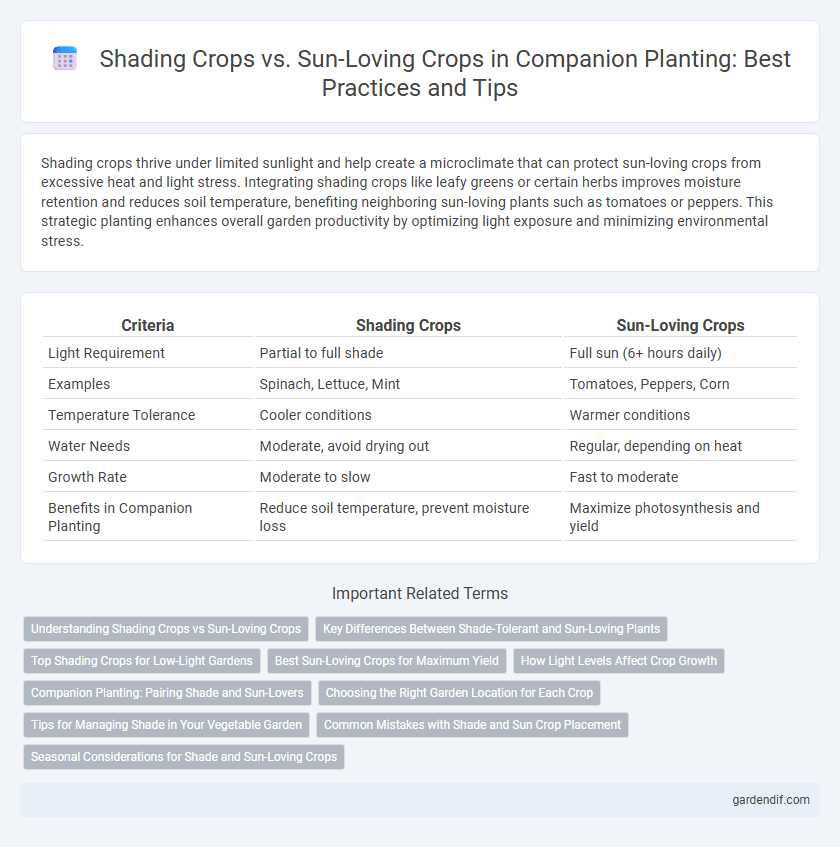
Shading crops vs sun-loving crops Illustration
Shading crops thrive under limited sunlight and help create a microclimate that can protect sun-loving crops from excessive heat and light stress. Integrating shading crops like leafy greens or certain herbs improves moisture retention and reduces soil temperature, benefiting neighboring sun-loving plants such as tomatoes or peppers. This strategic planting enhances overall garden productivity by optimizing light exposure and minimizing environmental stress.
Table of Comparison
| Criteria | Shading Crops | Sun-Loving Crops |
|---|---|---|
| Light Requirement | Partial to full shade | Full sun (6+ hours daily) |
| Examples | Spinach, Lettuce, Mint | Tomatoes, Peppers, Corn |
| Temperature Tolerance | Cooler conditions | Warmer conditions |
| Water Needs | Moderate, avoid drying out | Regular, depending on heat |
| Growth Rate | Moderate to slow | Fast to moderate |
| Benefits in Companion Planting | Reduce soil temperature, prevent moisture loss | Maximize photosynthesis and yield |
Understanding Shading Crops vs Sun-Loving Crops
Shading crops, such as leafy greens and certain legumes, thrive under partial shade and benefit from reduced sunlight exposure that prevents leaf scorch and excessive water loss. Sun-loving crops like tomatoes, peppers, and corn require full sun, generally six or more hours of direct sunlight daily, to maximize photosynthesis and fruit development. Selecting the right crop based on sunlight tolerance enhances growth efficiency and crop yield in diverse garden or farm ecosystems.
Key Differences Between Shade-Tolerant and Sun-Loving Plants
Shade-tolerant crops thrive in low-light conditions by efficiently utilizing limited sunlight through larger, thinner leaves and slower growth rates, whereas sun-loving plants require full sun exposure for optimal photosynthesis and typically have smaller, thicker leaves. Shade crops like spinach and lettuce prefer cooler temperatures and higher humidity, contrasting with sun-loving crops such as tomatoes and peppers that demand warmer environments and intense light for fruit development. Root structure also differs, with shade-tolerant plants often having shallower roots adapted to forest understories, while sun-loving plants develop deeper roots to access water in exposed, sunny habitats.
Top Shading Crops for Low-Light Gardens
Top shading crops for low-light gardens include leafy greens like spinach, kale, and Swiss chard, which thrive under partial shade and provide dense foliage to protect soil moisture. Root vegetables such as beets and carrots also perform well, benefiting from cooler, shaded conditions while enhancing soil aeration. Incorporating shade-tolerant herbs like mint and parsley promotes biodiversity and improves overall garden resilience in shaded environments.
Best Sun-Loving Crops for Maximum Yield
Sun-loving crops such as tomatoes, peppers, corn, and beans thrive under full sunlight, maximizing photosynthesis and yield potential. These crops require at least six to eight hours of direct sun daily to produce the highest fruit and grain quantities. Selecting heat-tolerant varieties and ensuring proper soil drainage enhances productivity and reduces stress on sun-loving plants.
How Light Levels Affect Crop Growth
Shading crops like lettuce and spinach thrive under filtered light, which reduces heat stress and prevents leaf scorch, optimizing photosynthesis in lower light conditions. Sun-loving crops such as tomatoes and peppers require full sunlight to maximize chlorophyll production and energy conversion, resulting in higher yields and robust growth. Understanding light intensity and duration is crucial for selecting companion plants that either benefit from or protect against direct sunlight exposure.
Companion Planting: Pairing Shade and Sun-Lovers
Companion planting combines shading crops such as lettuce, spinach, and kale with sun-loving crops like tomatoes, peppers, and beans to maximize garden productivity and create a balanced microclimate. Shading crops protect sun-sensitive plants from excessive heat and reduce soil moisture loss, while sun-loving crops benefit from increased air circulation and diverse pest control. This symbiotic pairing enhances growth rates, improves soil health, and reduces the need for chemical interventions in sustainable gardening systems.
Choosing the Right Garden Location for Each Crop
Selecting the right garden location is crucial when cultivating shading crops such as spinach or lettuce, which thrive in partially shaded areas and require protection from intense sunlight. Sun-loving crops like tomatoes, peppers, and corn demand full sun exposure, ideally receiving at least six to eight hours of direct sunlight daily for optimal growth and yield. Positioning shading crops under taller plants or near structures that provide natural shade helps balance sunlight needs, ensuring both crop types achieve maximum productivity in a companion garden setup.
Tips for Managing Shade in Your Vegetable Garden
Shade-tolerant crops like spinach, kale, and lettuce thrive in low-light conditions, making them ideal companions in shaded garden areas. Position sun-loving crops such as tomatoes and peppers in spots receiving at least six hours of direct sunlight to ensure optimal growth and fruit production. Use reflective mulches and prune nearby trees to increase light availability, enhancing photosynthesis and overall vegetable yield in shaded environments.
Common Mistakes with Shade and Sun Crop Placement
Shading crops often require partial shade environments, but placing them in direct sunlight can lead to wilting and reduced yields. Sun-loving crops demand full sun exposure for optimal growth, yet planting them in shaded areas causes stunted development and lower productivity. Common mistakes include neglecting crop light requirements and improper spatial arrangement, which disrupt growth cycles and reduce overall garden efficiency.
Seasonal Considerations for Shade and Sun-Loving Crops
Shade-loving crops such as lettuce, spinach, and kale thrive in cooler, shadier conditions typically found in early spring and fall, while sun-loving crops like tomatoes, peppers, and corn require longer daylight hours and warmer temperatures of late spring through summer. Seasonal considerations play a crucial role in maximizing crop yield by aligning plant selection with their preferred sunlight exposure to prevent bolting in shade-tolerant plants and ensure adequate fruit development in sun-dependent species. Proper scheduling and placement according to seasonal light availability optimize photosynthesis, growth rates, and overall plant health in companion planting systems.
Shading crops vs sun-loving crops Infographic

 gardendif.com
gardendif.com